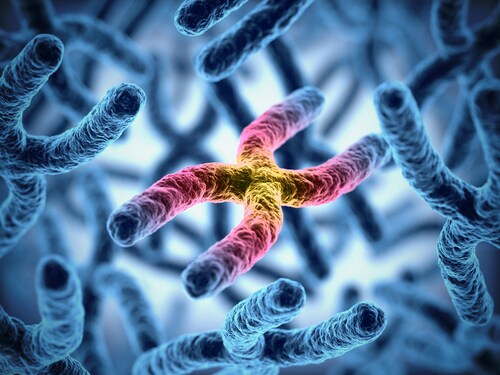 In humans, more genetic information is stored on the X chromosome than the Y chromosome. Since females have two copies of the X chromosome, dosage compensation through inactivation of one of the two sex chromosomes balances out genetic information. In this way, X inactivation equalizes gene expression between males (XY) and females (XX).
In humans, more genetic information is stored on the X chromosome than the Y chromosome. Since females have two copies of the X chromosome, dosage compensation through inactivation of one of the two sex chromosomes balances out genetic information. In this way, X inactivation equalizes gene expression between males (XY) and females (XX).
As Minajigi, et al explain, Xist RNA, a noncoding RNA, is the main regulator that orchestrates the silencing process occurring along the inactivated X chromosome (Xi). Past work has also implicated Xist as a recruiter, enlisting other (unknown) interacting factors. Minajigi and colleagues endeavored to further investigate the Xi interactome using direct RNA-interacting proteins (iDRiP) in a mouse model system.1 The team irradiated mouse embryonic fibroblasts (MEF) with cross-linking ultraviolet (UV) light for an unbiased screen of directly interacting proteins in MEF expressing physiological levels of Xist RNA. They also captured Xist-specific complexes using complementary oligonucleotide probes. Following this, the team used spectral counting and tandem-mass tags (TMT) to analyze proteins using an Orbitrap Fusion mass spectrometer (Thermo Scientific). This analysis revealed a large Xist protein interactome containing between 80 and 200 proteins.
To further examine Xist interactors, the team selected candidate proteins and employed an antibody capture (RNA immunoprecipitation–quantitative polymerase chain reaction) to verify interactions. As a result, the team determined that the Xist interactors fall into several functional categories, including cohesins, condensins, topoisomerases, RNA helicases, chromatin remodelers and histone modifiers.
Seeking to learn more about these functions, the team performed RNA immunofluorescence in situ hybridization (immunoFISH) of female cells. Notable in this experiment was an unexpected depletion of cohesins and SWI/SNF chromatin remodelers, suggesting the Xist interactors operate in different XCI pathways.
When the team performed knockdown experiments, cohesions were among the hits with the highest confidence and consistently destabilized Xi repression. To add to this data, the team examined activated X (Xa) and Xi binding patterns. Ultimately, the team determined that Xist RNA does indeed recruit repressive complexes (such as PRC1, PRC2, ATRX, mH2A and SmcHD1), as previously hypothesized. The team discovered Xist also repels architectural factors such as cohesins. This helps to avoid acquisition of a transcription-favorable chromatin conformation. When Xist is removed from the system, cohesins return to their default Xa binding state.
Focusing on how Xist interaction leads to cohesin repulsion, Minajigi et al. identified three types of repulsion. Type one repulsion included Xi-specific sites that do not depend on Xist. Type two included biallelic sites that are also Xist-independent. Lastly, type three repulsion included Xa-specific sites, many that cannot be established on the Xi because of active repulsion by Xist.
The researchers present this work as a model to examine gene silencing on a global scale. They maintain that this investigation, which delves into the Xi interactome, proves the importance of RNA in the organization of chromosomes.
Reference
1. Minajigi, A., et al. (2015) “A comprehensive Xist interactome reveals cohesin repulsion and an RNAdirected chromosome conformation,” Science, 349(6245), pii: aab2276. doi: 10.1126/science.aab2276.
Leave a Reply